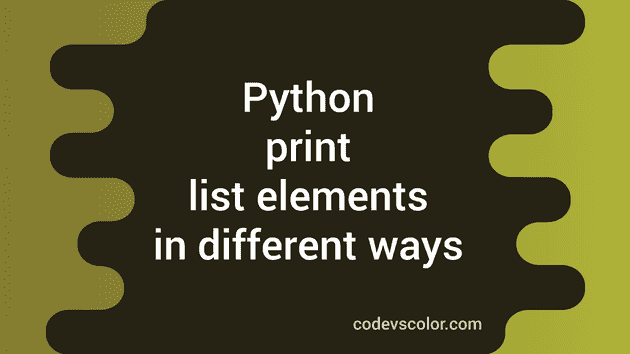How to print python list elements :
Python list is used to hold same or different elements. All list elements are placed comma separated inside a square bracket []. You can access the list items and read/modify/delete them using index. The index starts from 0, i.e. 0 is the index of the first element, 1 is for the second element etc.
Similarly, you can use indices to print one sublist easily. In this post, I will show you different ways to print a list in python.
Using indices :
If you print the list variable, it will print all values in the list :
my_list = [1,2,3,4,5,6,7,8,9,10]
print(my_list)
It will print :
[1, 2, 3, 4, 5, 6, 7, 8, 9, 10]
If you want to print only one part of the list, you can use indices :
list[first_index : last_index]
The first_index and last_index, both are optional. It returns one list from first_index to last_index, excluding last_index.
For example :
my_list = [1, 2, 3, 4, 5, 6, 7, 8, 9, 10]
print(my_list[:])
print(my_list[1:5])
print(my_list[:6])
print(my_list[6:])
It will print :
[1, 2, 3, 4, 5, 6, 7, 8, 9, 10]
[2, 3, 4, 5]
[1, 2, 3, 4, 5, 6]
[7, 8, 9, 10]
-
The first statement prints all values because we are not providing first_index or last_index
-
Second statement prints from index 1 to 4.
-
The third statement prints from index 0 to 5.
-
The fourth statement prints from index 6 to last.
Using * :
We can use * to print the list elements separated by a space :
my_list = [1, 2, 3, 4, 5, 6, 7, 8, 9, 10]
print(*my_list)
It will print :
1 2 3 4 5 6 7 8 9 10
You can also use one separator character :
my_list = [1, 2, 3, 4, 5, 6, 7, 8, 9, 10]
print(*my_list, sep = ',')
Output :
1,2,3,4,5,6,7,8,9,10
Using a for loop :
You can always traverse a list and print all items :
my_list = [1, 2, 3, 4, 5, 6, 7, 8, 9, 10]
for i in range(len(my_list)):
print(my_list[i])
It will print all items in the list each on new line :
1
2
3
4
5
6
7
8
9
10

